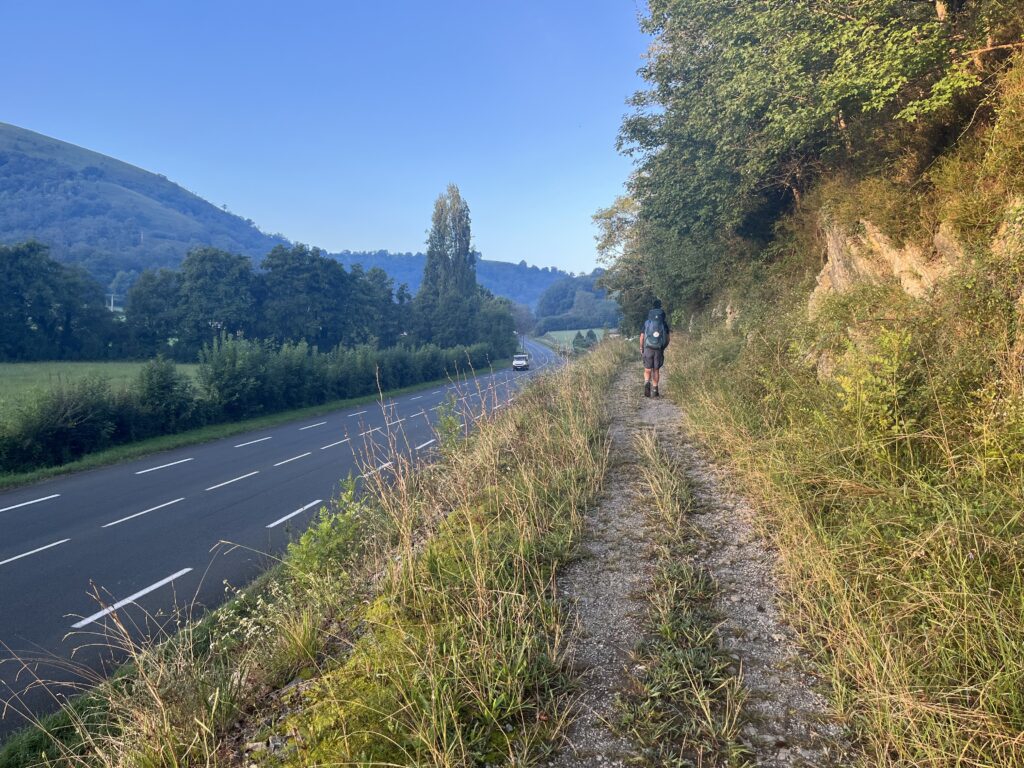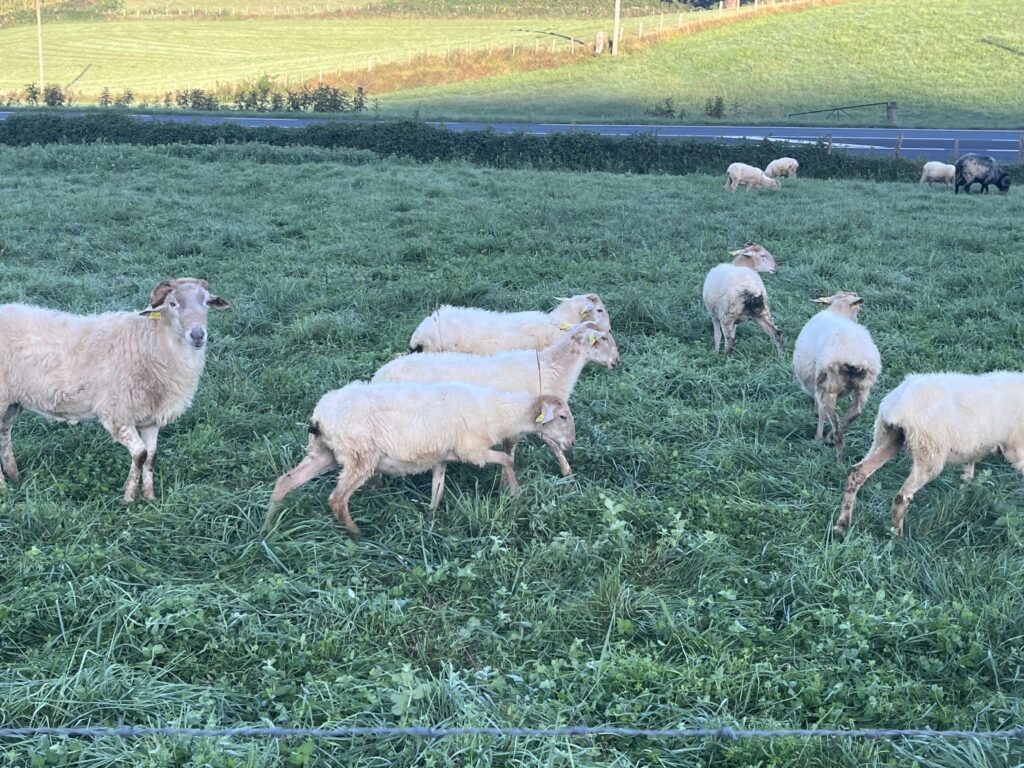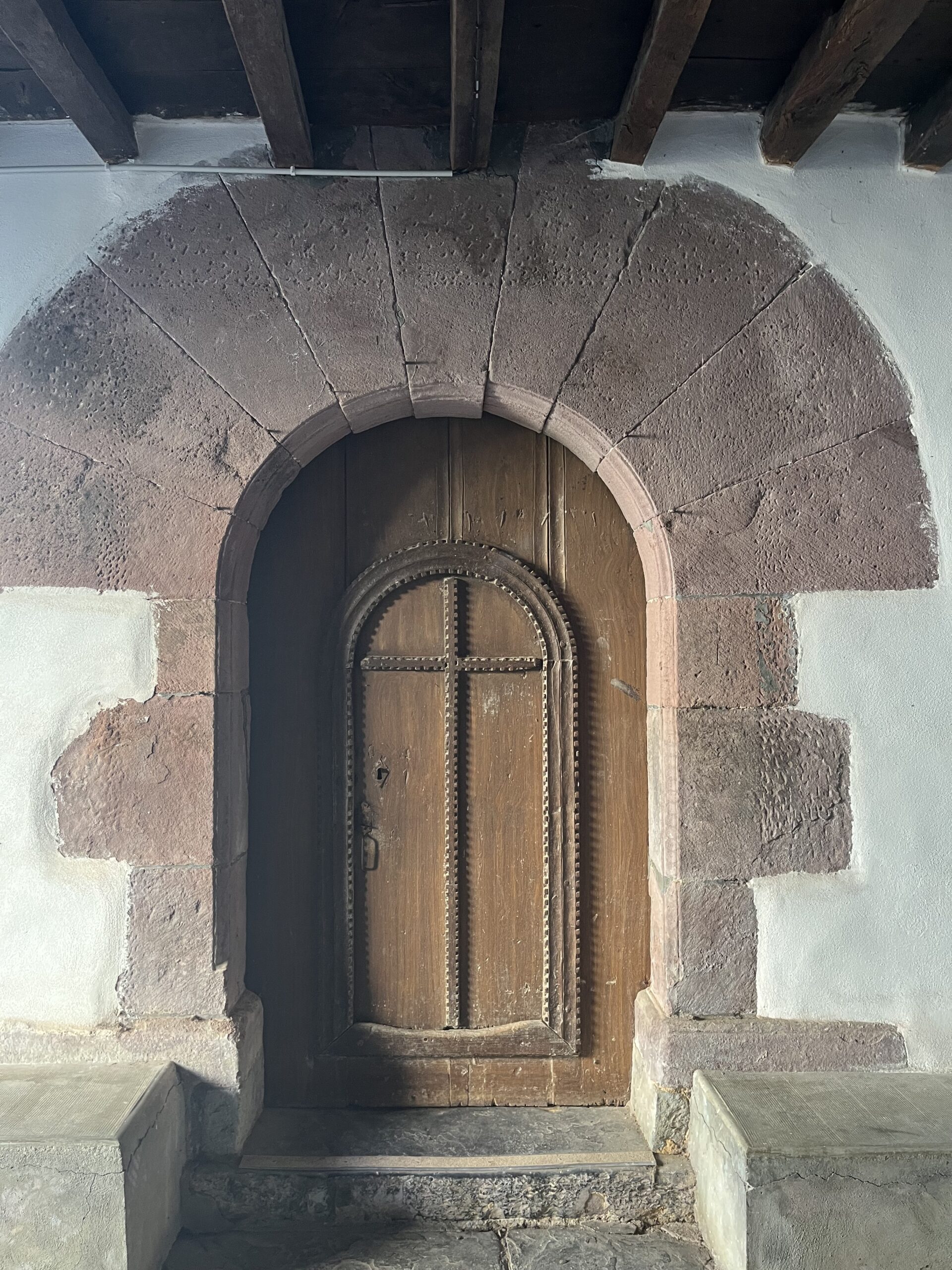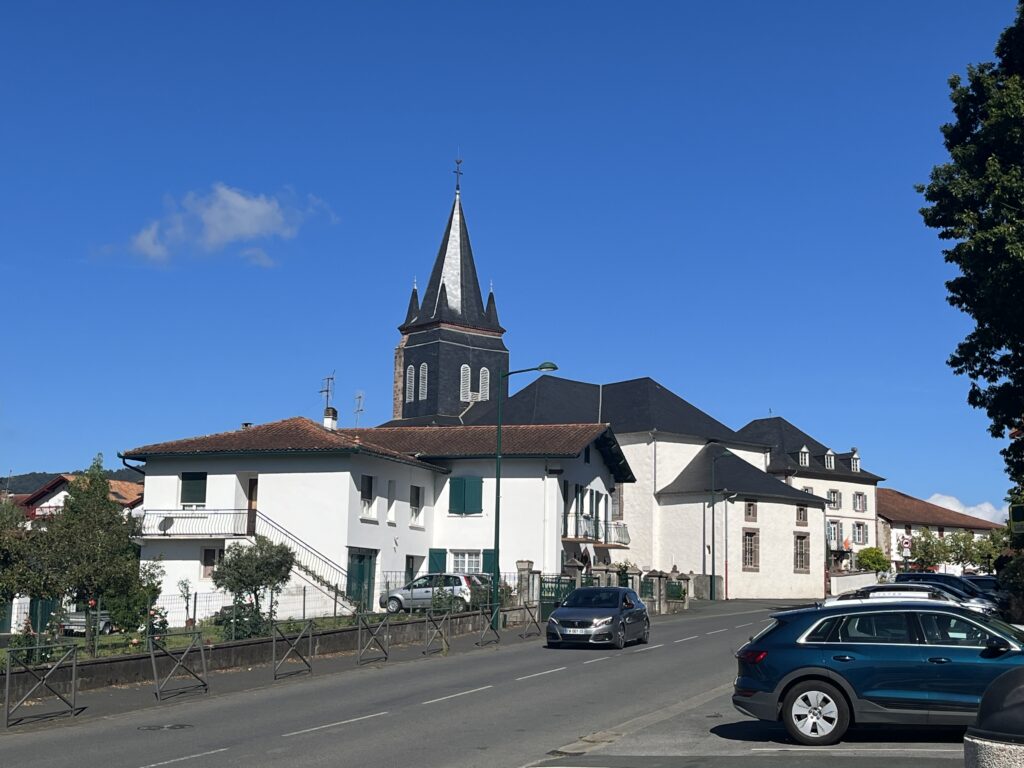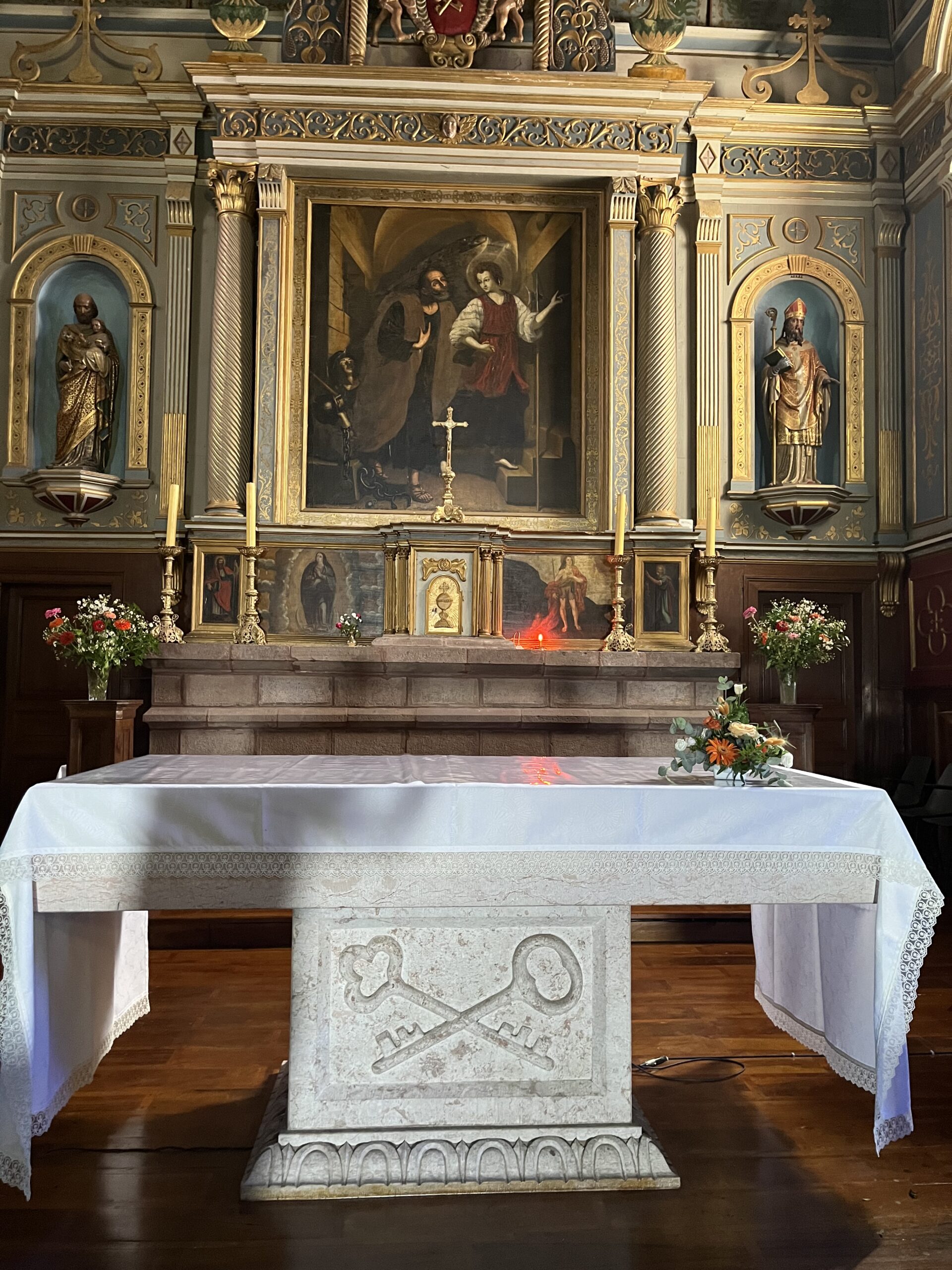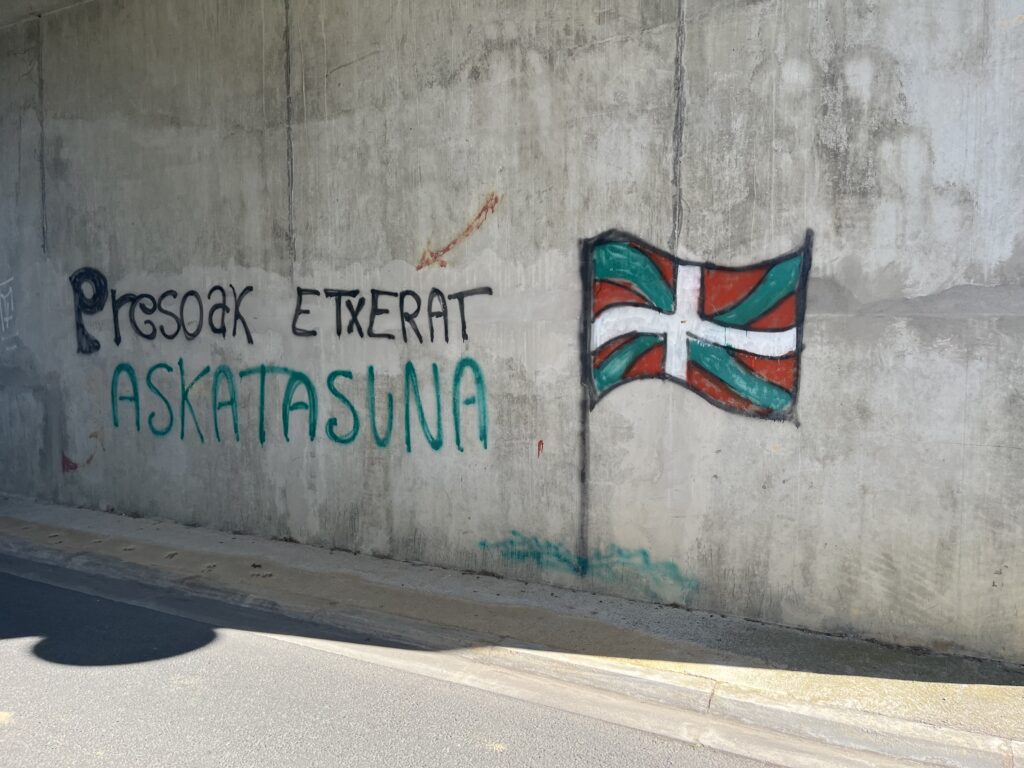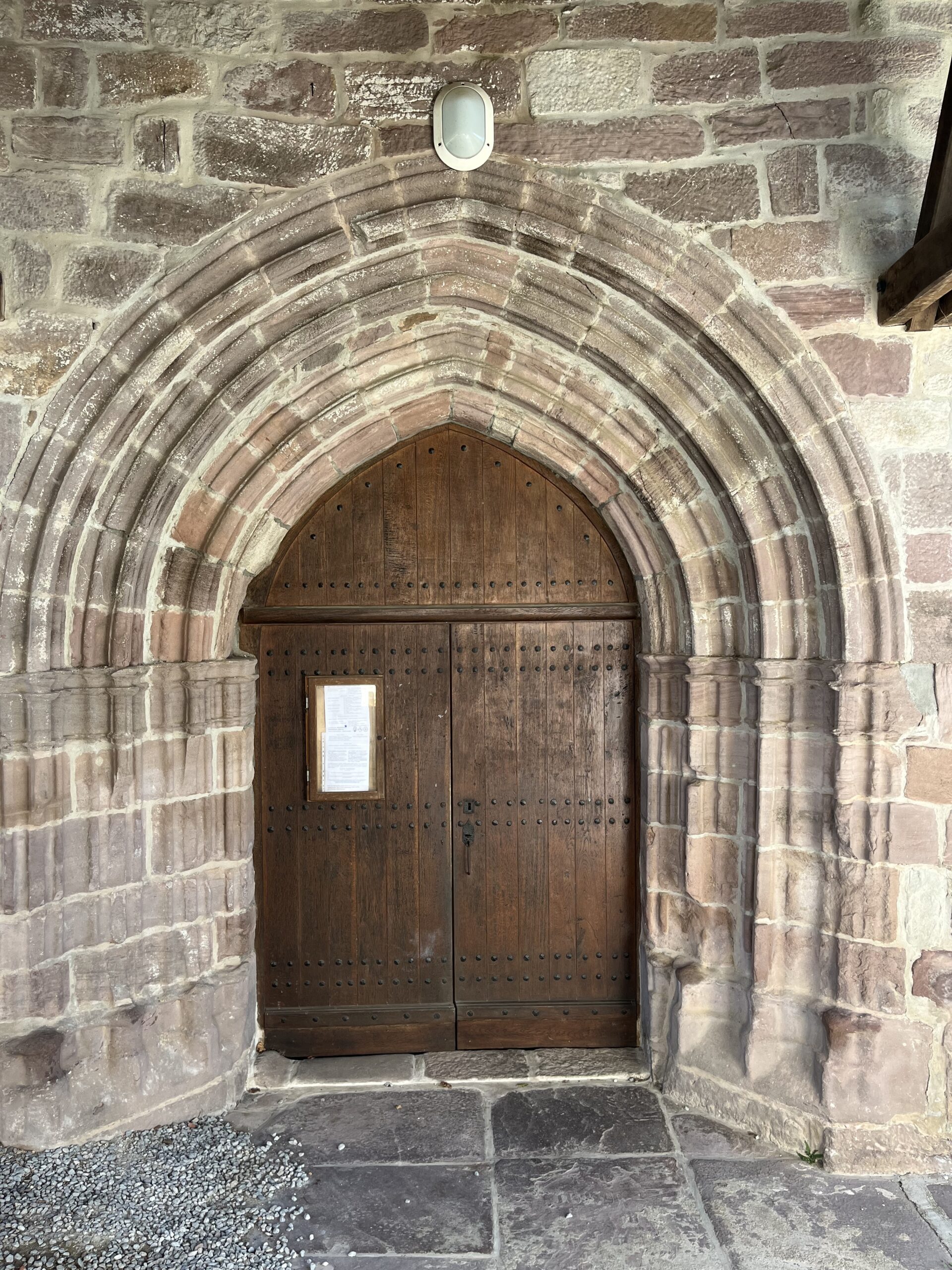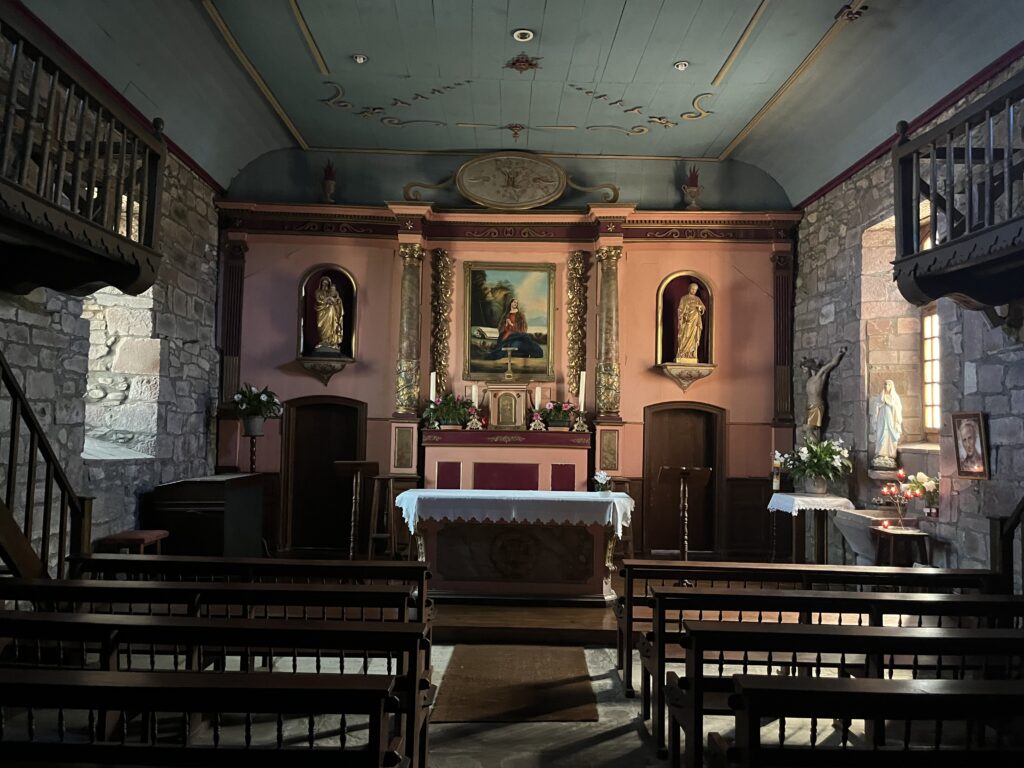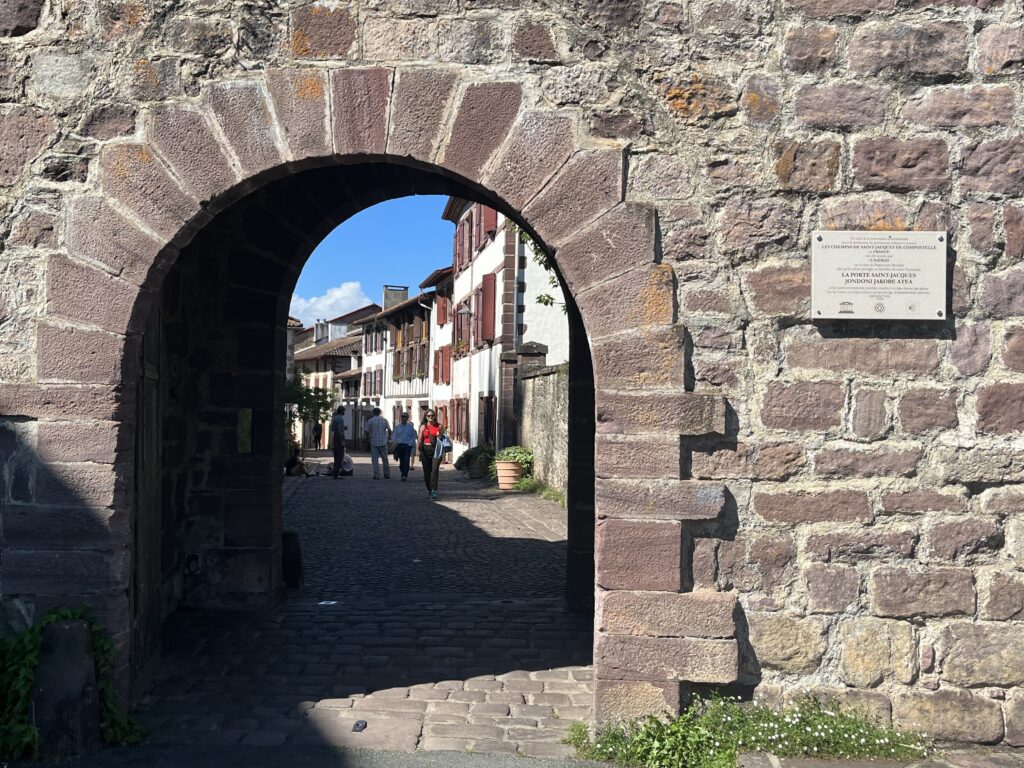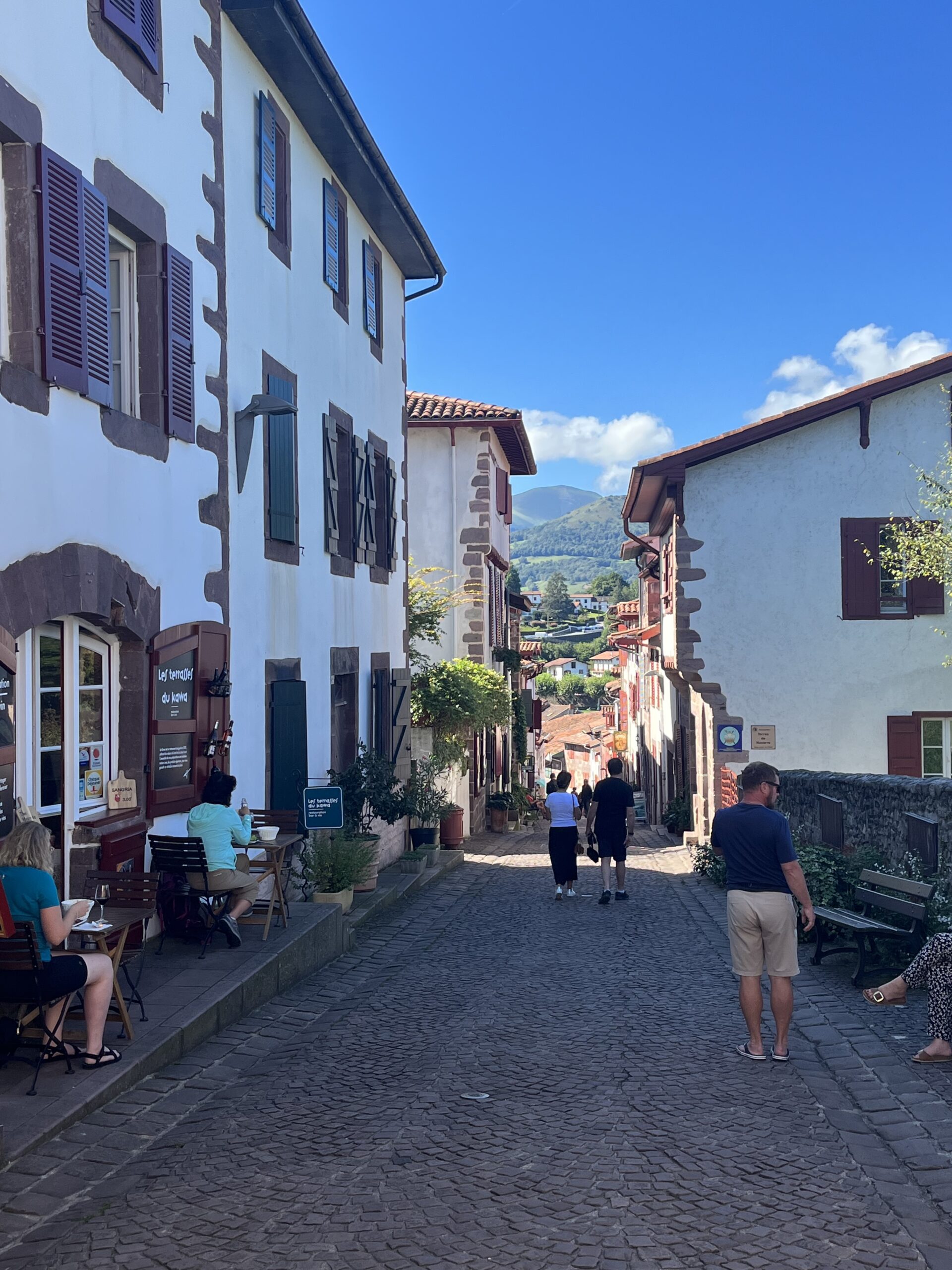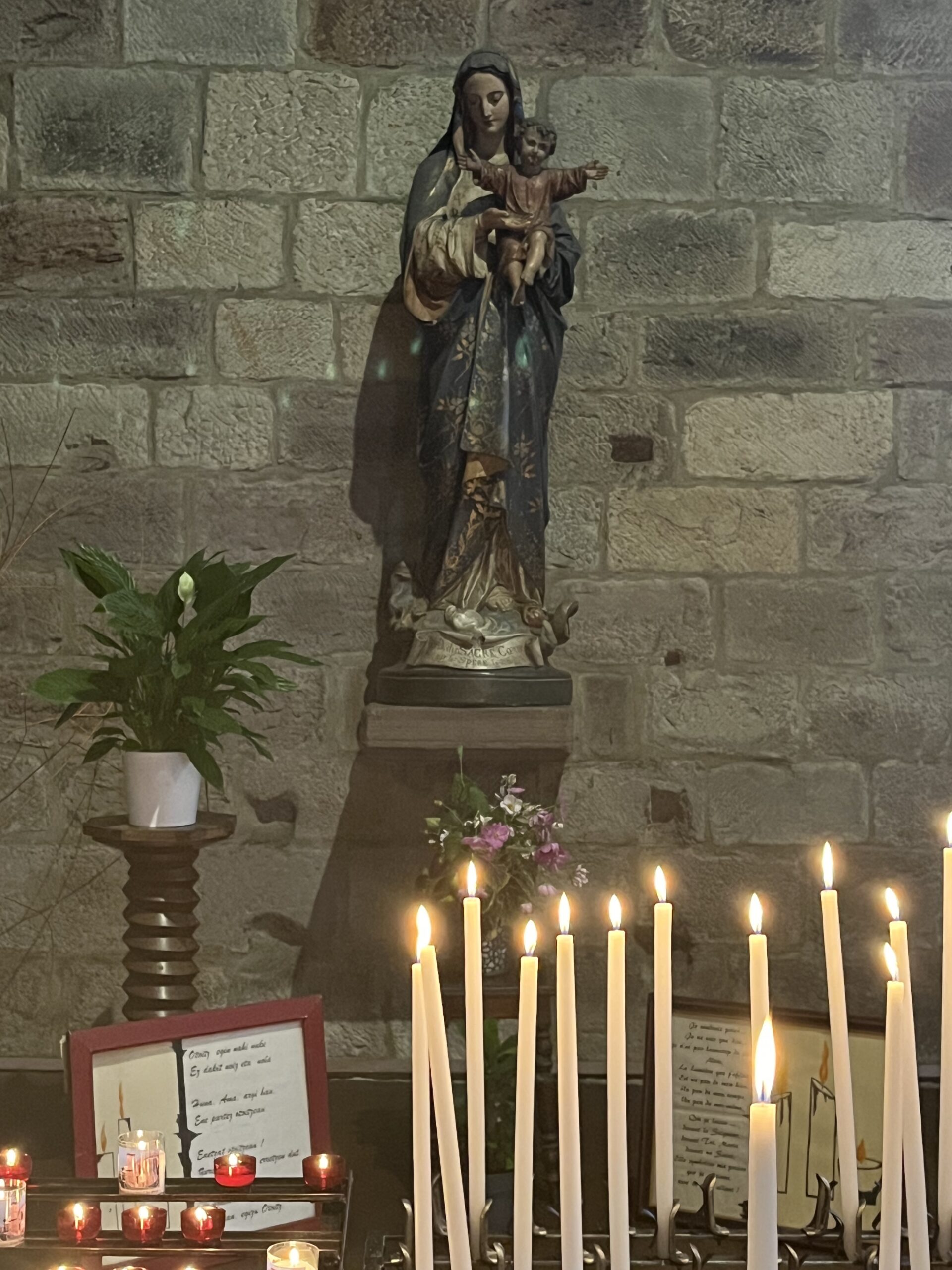Via Podiensis: to the Foot of the Pass
Just a quick word about last night’s gîte: magnificent! Wide and spacious dorms, but more importantly, gracious and amazing hosts. Dinner was outside on the terrace in full view of the beautiful Basque hills. And afterwards, there was a sing-along in French punctuated by our host playing accordion and singing traditional Basque folk songs. It was just a great experience.
I left the gîte at just before dawn about seven. We had been warned about aggressive bees, or possibly wasps – it was unclear – about 2 km down the road. I definitely wanted to be past them before it was too light outside. As a precaution, I was wearing a bug net, long sleeves, and gloves.
It may sound like a lot of precaution, but really the last thing I need is to be stung by wasps and then have to walk another 20 km.
For the first kilometer or so, the path was alternating stone and dirt – mud, really – under dense tree cover in darkness. Thereafter, the Camino turned onto a road that headed out through open fields. In the distance, I could hear cows and crows, with an occasional rooster.
It was late enough now that I turned off my flashlight. I passed through several farmsteads, where I could hear but not see the inhabitants stirring and moving around. A tractor rumbled in the distance.
The Camino turned to become a sidewalk next to a pretty busy two-lane road. It was about 7:30, and I was more than 2 km into the walk. It was probably safe to remove the gear at this point, but I thought I’d give it another kilometer just to be sure.
The Camino left the busy road to turn onto the quiet lanes of the village of Larceveau.
At the 3 km mark, I took off the gloves and net. It was chilly enough that I kept the long sleeves on. I’ve never seen a bee or a wasp, and for that I was grateful.
I was a roadwalking through suburban Basque country: a steep hillside with pastures and trees to one side, relatively flat land with houses on the other.
Many of the houses had the family name, or a longer inscription in French or Basque, on a stone or wooden plaque facing the street. These were written in a very distinctive font, sometimes with the swirly cross that represents Basque country. I even saw a plaque with the distinctive arms of the long extinct Kingdom of Navarra.
And then it was through another tiny village and onto a grass track between pastures of sheep on one side and cattle on the other. after this too brief pastoral Interlude, the path turned once again to the trees. After a while, this once more opened up into hilly meadowland.
It was a glorious and beautiful early morning walk. Alas! My comfortable dirt and grass trackway inevitably became asphalt once more. The Camino passed by any number of farmsteads, sheep pastures, and even the odd cornfield. The sky was a nearly cloudless light blue, and the rest of the world was, by and large, a million shades of green. Nearly every building was white or cream colored, with the red trim so characteristic of the Basque country. It’s easy to see why the Basque colors are red, green, and white.
The Camino passed through a cattle gate, and once again was a narrow dirt track through meadows and trees. Somewhere in the distance was a cacophony of cowbells. The early morning light glinted emerald off of every surface. It was glorious.
I passed through another cattle gate, and the Camino briefly became gravel path on a bluff overlooking a highway. The path descended, and soon it was basically a wide asphalt sidewalk next to the highway. Around me, hills loomed, some forested and some speckled with sheep.
Soon it would be another cattle gate and another dirt path, though it was once more overlooking the highway. I keep calling them “cattle gates”, but the only animals I’ve seen around here are sheep, so I suppose technically they’re “sheep gates”.
And there was another round of the game of sheep dodging today. I just don’t understand why those critters won’t get out of the path.
And then another gate, and back to the highway. After just a little while the path disappeared, and I was walking on the shoulder of the highway. Fortunately, the Camino soon turned down a much safer feeling country road through meadow land, where the primary vehicles were tractors rather than speeding cars and trucks.
For a short while, I walked with Annika, a physiotherapist from Amsterdam. She was new to this whole Camino thing. Her first day was yesterday, and I had helped her find her first gîte. This morning, I showed her how to use hiking poles properly. She is walking short days, so I am unlikely to see her for very much longer. She is walking all the way to Santiago, though, and I have a couple of scheduled rest days, so who knows?
The farm road continued through the beautiful, rolling hill country until the village of Gamarthe. Here I prayed once more in the covered narthex of a locked church. This was the medieval church of Saint-Laurent, which I had really hoped to properly visit. I did find it amusing that the town hall is located in a loft directly above the narthex of the church.
I stopped for coffee nearby, and was soon joined by Annika and Philip, a Frenchman who is also walking from Le Puy to Santiago. This is where I finally took off my long sleeves. After just a short break for coffee and conversation, we all individually continued on.
From here it was a roadwalking until the end of the day through verdant hills, pastures, and farmlands. There was even a brief sojourn through the woods. All in all, a lovely walk.
I came to the village of Bussunarits just before 11 AM. I was hoping for a café, but no such luck. Not even a picnic table. A little after the village, I passed an old-school château – with turrets, no less – that actually appeared to be inhabited. Here I found a bench where I sat and ate an odd mishmash of things out of what was left of my food stash for second breakfast.
After some uphill forest sidewalk walking, I entered what I initially thought was another village, but instead turned out to be the outskirts of the town of Saint-Jean-le-Vieux.
This town is a place with some history. It was originally a Roman camp. It became an important early medieval site before it was destroyed by King Richard the Lion-Heart in 1177. Afterwards, the inhabitants of the town were evacuated and they rebuilt nearby in Saint-Jean-Pied-de-Port. It was only much later that the original site of the town was re-inhabited.
I arrived in the center of town just after 11:30 AM. I made my visit to the parish church. Quite unassuming on the outside, although it is in fact the 12th century church of Saint-Pierre d’Usakoa, rebuilt when the town was re-inhabited, and rebuilt again after being destroyed again in the wars of religion in the 16th century. The altars are all a sort of exuberant neo-classical. A captivating painting hangs above the high altar depicting the angel sneaking Saint Peter out of prison.
Got slightly lost getting out of town, but with the help of Philip, who I ran into at the church, we were able to get back on track. Also saw my first pro Basque independence graffiti. There will be much more.
Once more, it was back to roadwalking through the beautiful Basque countryside and a succession of tiny villages/suburbs.
I stopped by to pray in the little 14th century Church of the Magdalene. Again, the small church had been rebuilt several times over the centuries and is now graced with a neoclassical sanctuary.
At 12:38 precisely, I arrived at the Porte Saint-Jacques, the gate into the town of Saint-Jean-Pied-de-Port, and the place where Francine and I started our 2016 Camino.
Many, many pilgrims begin their Camino in Saint-Jean-Pied-de-Port, and the Pilgrims’ Quarter is like a Camino Disneyland. It’s hard not to get caught up in the excitement of all these fresh-faced pilgrims just starting out, with their clean clothes and new backpacks.
I ran into my old walking buddy Bruno, as well as Álvaro, my more recent friend from Argentina, and we got caught up.
Then I found a likely spot for lunch and methodically destroyed an omelette.
Afterwards I waited in line at the Pilgrim Office so I could get my credential stamped. This was not a short line. I was there from about 2 PM until about 3:45. Actual time in the pilgrim office was perhaps 10 minutes of very useful information and, just as important, stamping my credential.
Tomorrow I’m taking a much needed rest day here, so I will make some additional comments about the town and the church there tomorrow.
Date: 19 September 2023
Place: Saint-Jean-Pied-de-Port
Today started: just past Ostabat-Asme / Izura-Azme
Today’s Photos!





